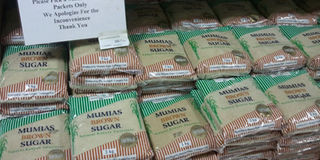Sugar: Why Kenya should stop the fight

A notice limiting the amount of sugar that customers can buy at any given time from the outlet.
What you need to know:
The noise from Kenya over a sugar deal between President Museveni and president Uhuru Kenyatta could have been blown out of proportion. Ismail Musa Ladu looks at why such agitation should not be there at all.
“We support mutually beneficial Kenya-Uganda trade but we will never allow President Museveni to export dictatorship to Kenya,” opposition Budalangi MP Ababu Namwamba said in reaction to Museveni’s statement urging Ugandans and Kenyans to ignore the opposition against the sugar deal.
Namwamba, whose constituency is located in the Busia County bordering Uganda, could have directed his warning at an individual but was sour and outlandish to a country which is one of Kenya’s biggest markets.
A 2014 report from Kenya National Bureau of Statistics indicated that Kenya exported goods worth Shs2.4 trillion to Uganda, coming ahead of Tanzania and US at Shs95b and Shs159b respectively.
Amid all the large trade partnership between the two East African countries, Uganda’s exports to Kenya stand at a dismal Shs530b.
However, over the years, there has been sustained reduction in Kenyan imports, reducing by more than Shs153b in 2014.
The scaled up production has seen a number of sectors grow their production with the sugar sector registering an annual surplus of more than 148,500 metric tonnes.
Surplus production
Uganda, according to Jim Mwine Kabeho, the Uganda Sugar Manufacturers Association chairman, produces 508,500 metric tonnes annually against consumption of about 360,000 metric tonnes.
The surplus, Kabeho says, has forced manufacturers in Uganda to seek for new markets with key targets being Kenya, whose troubled sugar industry has created a daily stock shortage of 4,000 tonnes.
Although the Kenya opposition says the shortage is artificial and the work of sugar barons, the country’s Agriculture Fisheries and Food Authority, recently said sugar stock volumes in all its 11 factories had fallen to 3,678 tonnes way below the required 9,000 tonnes daily.
The events in Kenya could perhaps be the reason why the entire East African region is facing a sugar shortfall of more than 200,000 metric tonnes.
Richard Sezibera, the East African Community (EAC) secretary general, told this newspaper last week that the “only difference is that Uganda has a slight surplus but the region still has an annual sugar shortage of more than 200,000 metric tonnes”, highlighting that there is still a larger market within the region.
But how did Uganda get into a surplus amid a large regional deficit?
A drought in 2010, which severely hit the cane sector, forced Uganda into a sugar crisis in 2011 with prices rising to as much as Shs15,000 a kilogramme.
However, according to Ssebagala Kigozi, the Uganda Manufactures Association (UMA) executive director, the country had learnt the hard way, embarking on sustained planning and research, “which has seen the country where it is today”.
“Thoughtful planning has allowed us to turnaround the sugar sector,” Silver Ojakol, the commissioner for external trade at the ministry of Trade says, explaining how Uganda has encouraged more than 10 large and small scale sugar manufacturers to come on board across the country.
But beyond the establishment of new factories, Moses Ogwal, the Private Sector Foundation Uganda policy analyst, says manufacturers took advantage of the deficit and “…went into research to improve production”.
This, according to James Mutende, has seen the country grow its capacity with “claims that Uganda repackages imported sugar. These claims are not true and are a perpetuation by Kenyan politicians”.
Who wins, who losses?
The ultimate losers will be “the manufacturers, who will have to cut back on production if they don’t get anywhere to export the surplus”, according to Ssebagala.
Farmers, Ssebagala says, will be curved in the mix as they will have no market for their cane.
However, beyond manufacturers and farmers Kabeho believes the biggest losers will be the EAC as it is a “reality check for the integration and if it is not handled well, it could be the beginning of a review of the entire relationship”.
But for Sezibera, the sugar impasse is not an issue and should not be given attention considering that the two countries involved have trade relations that are bigger than mere sugar.
The large trade, which according to Ojakol, is tilted towards Kenya, could be the biggest causality not considering the already large presence of more than 300 Kenyan companies in Uganda, which does not compare well with the less than 20 Ugandan companies in Kenya.
Lessons for Kenya
According to Were Anzetse, a development economist based in Nairobi, “Kenya should not allow political considerations to cloud the hard economic sugar realities,” but look at both short and long-term solutions.
Were’s view is supported by president Kenyatta who recently castigated Kenyan politicians for mocking a deal whose interests are purely for the integration of the region.
“It is more sensible to have a deal with Uganda than import sugar from Brazil every time we have a shortfall,” Kenyatta said recently.
Thus the key issue here should be a sincere approach to promoting regional trade and solving the sugar shortage, which Were says “must be more efficient, productive and competitive”.
But for Ogwal, Kenya should be more sincere and allow Ugandan companies to supply where they have fallen short.
Allowing free trade within the region, according to Ojakol, could be the way that could allow the achievement of regional integration which even after years continues to be fast-tracked.
The ping pong in kenya
Last month, president Uhuru Kenyatta led a delegation from Kenya to Uganda in which a number of trade deals touching sugar, milk and beef were discussed.
However, before the ink, which signed the deals could dry, Kenya’s main opposition leader Raila Odinga rushed at Kenyatta for what he called a bad sugar deal that could kill the country’s sugar potential calling for its immediate
cancellation. Since then the dust around the sugar deal has not settled and could now have turned political. Whereas Kenyatta says government cannot ignore the current shortage, Raila Odinga says the deficit is artificial and a creation of sugar barons.
The situation in kenya
Unlike Uganda which produces a surplus, Kenya has a huge sugar deficit with the country producing an annual average of 600,000 metric tonnes against a consumption rate of between 800,000 and 850,000 metric tonnes, according to the country’s Agriculture Fisheries and Food Authority.
Kenya’s daily sugar stock piles have also reduced to 3,678 tonnes against a required 9,000 tonnes, which has plunged the country into perennial shortfalls.
This year could be worse with the country’s largest miller – Mumias - being challenged financially, a factor that has forced the Kenyan government to give it occasional bailouts.




